Kistler Building
The Kistler Building was located at 633-641 Sixth Ave. No. on the southeast corner of Sixth and Lyndale. It housed a number of important jazz and R&B clubs on the North Side.
Much of this early history comes from the article “Dust of Jazz Era Rises From Ancient Building” by Don Morrison, Minneapolis Tribune, November 10, 1957.
THE BUILDING
1889
The building was originally the 17-room mansion of Doctors J.M. and Charles M. Kistler, built in 1889 at a cost of $15,000. The Kistlers attended to the Jewish population in North Minneapolis, living and working in the building. They and their families lived in two apartments on the second floor of the 50 x 90 ft red brick building. James Kistler built the building and ran a grocery store on the first floor.
Because there were three floors and so many different venues through the years, the following chronology is impossibly non-linear. But I’ve used ads and news articles as best as I could to try to put together a picture of what kinds of things were happening in this iconic building. Imagine what you could see and hear in the Kistler Building!
THIRD FLOOR
From the beginning through 1926, the third floor hall was originally rented out to various groups for lectures, meetings, dances, card parties, and even weddings. It was clearly used as a community space for various political, social, and fraternal groups in the neighborhood.
1898
For example, in 1898, the United Pleasure Club announced a series of dances to be held at Kistler’s Hall, with Hamlin’s Orchestra providing the music. “This popular organization grows steadily in public favor and its parties are always well attended.” (The Irish Standard, October 15, 1898)
ODD FELLOWS: 1899 – 1905 THIRD FLOOR
One of the original tenants of the building was the John White Lodge No. 150 of the Odd Fellows, situated on the third floor. On September 18, 1899, the Lodge gave a social reception to its members and friends in its new hall, attended by 400 people including Dr. J.M. Kistler. This might have been a dance, since a floor manager was mentioned. (Minneapolis Tribune, September 22, 1899).
The Lodge regularly gave dances, “social hops,” masquerades, and card parties. The last mention of the Lodge in the papers was in February 1905.
ATLAS CLUB – 1907 – 1918 THIRD FLOOR
This appears to be an athletic club dedicated mostly to boxing, although they did make the hall available to other groups. It was in the Kistler Building by at least 1907. The organization moved and then disappeared in the fall of 1918.
1908
EMMA GOLDMAN SPEAKS
The hall was still available for speeches, apparently. on March 27, 1908, Emma Goldman, “the diminutive apostle of anarchy,” addressed a standing room only audience at Kistler’s Hall that was expecting her to speak Yiddish. Instead, it was given in an “Hebraic readjustment of high German,” which disappointed some of the crowd. The audience was also disappointed that she was not more radical in her speech, which compared the social body to a large family where people pitched in to help each other out. This does not sound radical at all. The crowd grew restless. Her next speech would be given in English on the topic of the Emancipation of Women.
MEMORIES OF THE KISTLER BUILDING
As the building was coming down, Marie Cullen wrote down her childhood memories of it and the neighborhood and they were published in the Minneapolis Star on December 4, 1957. She remembered buying groceries at James Kistler’s store, and going up the stairs (presumably to the second floor) “where old Doctor J.M. and young Dr. Charlie held forth. The smell of Iodoform and mysterious disinfectants usually assailed our nostrils as we began to reach the top of the stairs. Dr. J.M. was so good and kind. He had a horse and buggy and would always come – night or day – and was never known to send a bill.”
1920
MASONIC LODGE, 637 Sixth Ave. No. THIRD FLOOR
In 1920 the hall was used by the Masons, their female counterpart Eastern Star, and the related Scottish Rite, as evidenced by this excerpt of the Minneapolis directory from that year, provided by Buzzy Bohn:
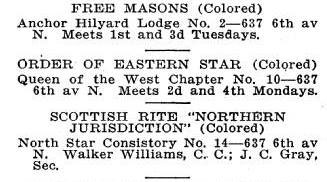
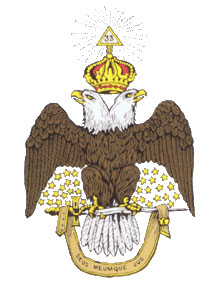
Scottish Rite Double Headed Eagle
AMES LODGE/ELKS HALL: 1921 – 1930 THIRD FLOOR
Ames Lodge No. 106, Order of Elks, Improved Benevolent Protective Order of Elks of the World. This Lodge of the IBPOE was founded in October 1906. From June 1 , 1921, to November 4, 1922, the Minnesota Daily Star referred to the third floor as the Colored Elks Hall. Dances were held three times a week and on holidays. By June 11, 1924 to at least 1925 it was called the Ames Lodge or the Elks Hall. The Elks had moved to 148 Highland by 1933. Read more about the Elks Here.
1926
In 1926, Dr. Kistler sold the building to Ben Kaplan for $45,000. The first floor was shared by the Western State bank and a pool hall, and the second floor had four five-room apartments.
APEX HALL, 635 Sixth Ave. No – 1933 – 1936 THIRD FLOOR
The Apex Club opened in the third floor, described wryly in a news story in 1932 as a place dispensing “entertainment, food, and cracked ice.” The Apex was what we now call a “black and tan” place, pretty evenly habituated by anyone who liked jazz. It was a place for after-hours jam sessions.
Just when it was open can be confusing – it would get raided, padlocked, re-open, etc. Ads tell the tale. This listing of dances may seem tedious, but maybe some descendant of one of these folks will google their ancestor and find him or her on this page. It does happen!
***PLEASE NOTE*** There were a lot of ads for the Apex in the Minneapolis Spokesman. They are all text and I would have to retype them anyway for them to be searchable. So I made the decision not to recreate them here, but just to retype them as true to the original as possible. Any ad without attribution comes from the Minneapolis Spokesman. I apologize for any personal remarks. Believe me – I would have LOVED to have gone to the Apex!
1933
The Apex Nite [Klub] opened in October 1933, and featured an “all Colored Floor Show” produced by and featuring Jimmie White, Assisted by:
- Aurora Edwards
- Jessie Scott
- Bill Pugh’s Orchestra
- The Apex Dancing Girls, direct from the Grand Terrace Cafe in Chicago
Not sure why it says formerly the P&S Chicken Shack. That’s a whole other problem left to tackle.
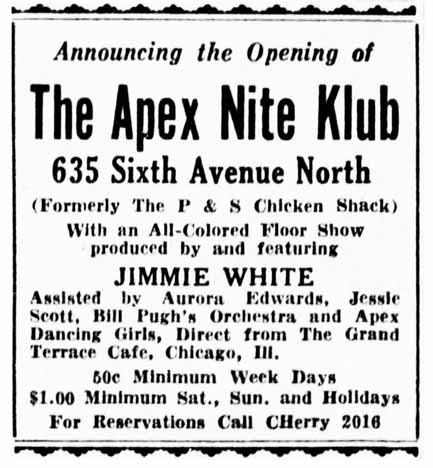
Minneapolis Tribune, October 14, 1933
The ad below from October 23, 1933, indicates that luminaries Harry Pettiford and Rook Ganz are members of the Apex Orchestra!
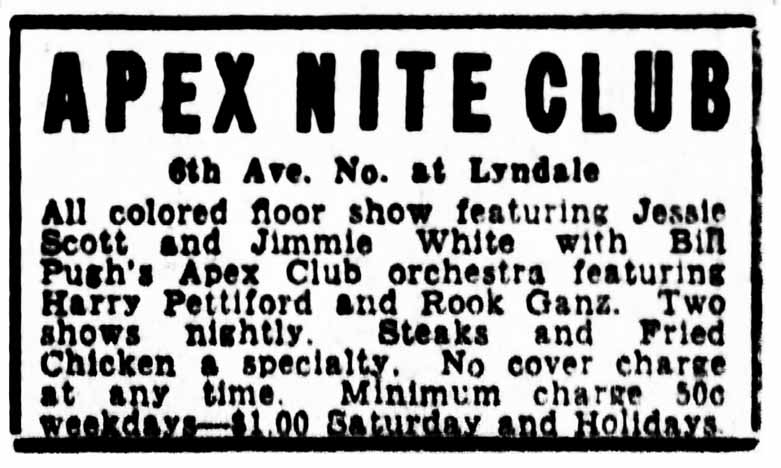
Minneapolis Tribune, October 23, 1933
December 9, 1933’s ad announces a new floor show with 12 people, direct from the Little Harlem Nite Club in Buffalo, New York. It was produced by and featured Pedro Lane, with the Rodgers and Bennie Hoofers. Not to mention a chorus of six Torrid Brown Dancing Girls. Music provided by Bill Pugh’s Orchestra.
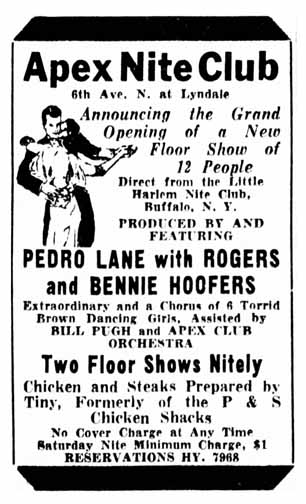
Minneapolis Star, December 9, 1933
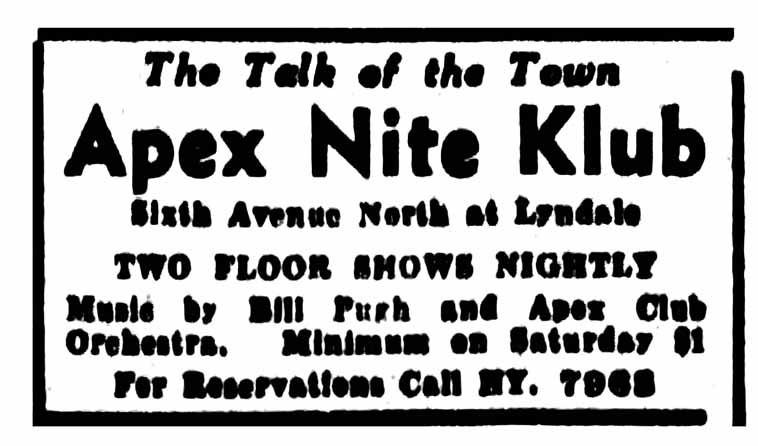
Minneapolis Tribune, December 16, 1933
1934
A raid was executed at the club in January 1934, and among the patrons after hours, who did the police find but Kid Cann his own self, along with Ben Wilson, the so-called “Mayor of the North Side.” They also found two five-cent slot machines, which got Wilson arrested and the machines seized. Cann, of course, wasn’t touched. (Minneapolis Star, January 15, 1934)
On January 17, 1934, the Chief of Police asked the (actual) Mayor to revoke the license of the Apex Club after Ben Wilson was arrested on charges of violating the closing time ordinance and for having gambling devices, was fined $100 when found guilty of both charges. Wilson described himself as an assistant manager and that he worked for “Tiny” Holder, a woman who held the license for the club. The woman told the Chief that she was backed by Kid Cann and by Wilson. (Minneapolis Star, January 17, 1934)
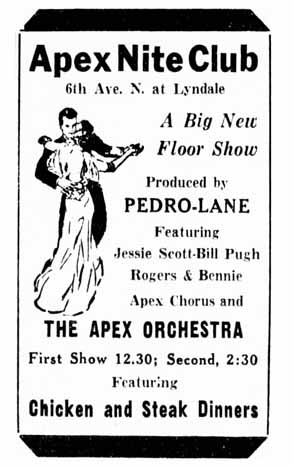
Minneapolis Star, January 19, 1934
As a result of the raid, all licenses were revoked on January 23, 1934. It re-opened a month later under new management. The ad below says the manager is Joe Levy.
In February 1934 we have a Matinee Dance at the Apex featuring Robert Freeman and Willie Davenport and their Brownskin Follies.
On March 17, 1934, the Apex presented “Flashes of 1934,” produced by Pedro Lane. The floor show includes:
- Rogers & Benny
- Georgie Boy
- Bobbie Davis
- Jessie Scott
- The Apex Orchestra
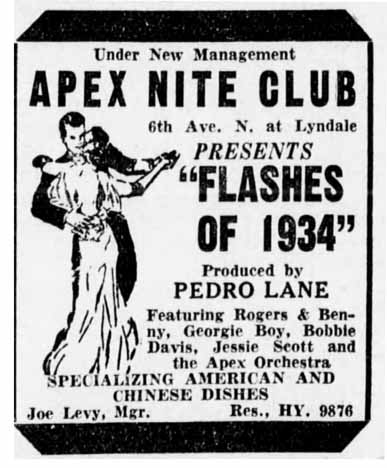
Minneapolis Star, March 17, 1934
In April 1934 we have Frank Hines and His Rhythm Venders, featuring Kelly Stone’s and Eddie Estes’ Brownskin Follies with Dorothy and Gwendolyn.
On December 9, 1934, entertainment is provided by Rook Ganz and his Radio Broadcasting Cotton Club Orchestra. There were two Cotton Clubs – the notorious North Side Cotton Club where a policeman was murdered in 1928, and the roadhouse in St. Louis Park that continues today as Bunny’s. This one is the St. Louis Park Cotton Club.
On December 16, 1934, the Balloon Club presented Rook Ganz and his WTCN Radio Broadcasting Cotton Club Orchestra at a Cut Rate Matinee dance (admission 35 cents).
The next interesting one is on Christmas Eve 1934, with Rook Ganz and Scottie Williams and His Black Cats. Also Mae Nolan, Burlesque Star Will Give Her Late Snake Hips Dance.
The Christmas Afternoon dance featured the very popular Eli Rice and his Dixie Cotton Pickers Orchestra. They took a 90 minute break and played for the Grand Christmas Ball for 1934.
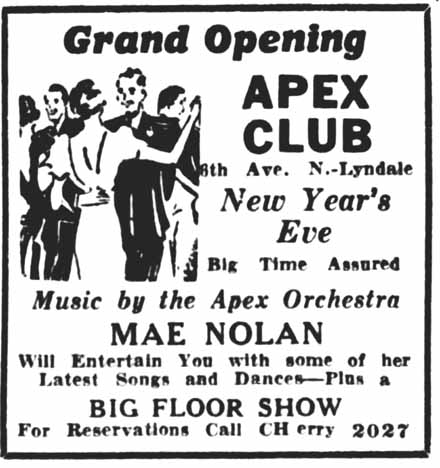
Minneapolis Star, December 29, 1934
1934
HALFWAY CLUB, 635 Sixth Ave. No. SECOND FLOOR
The Halfway Club was on the second floor of the Kistler Building, where the Clef Club musicians might go if the third floor closed down at 4 am.
1935
Every Sunday afternoon beginning on January 13, 1935, Eli Rice provided music for a matinee dance.
Except that on February 17, 1935, the matinee dance presented Robert Freeman and Willie Davenport and their Brownskin Follies from the South Side Auditorium, with the Sizzling Star Ethel Cross. All for 35 cents! The presence of Ethel Cross may have meant that the South Side Auditorium was no longer available for dances.
This fabulous show was repeated the next two Sundays with music by Mack Swain and his Orchestra.
Mack Swain and his 14 piece band was back on Sunday night, March 10, 1935 for a Big Breakfast Ball that started at midnight and ended at 6 am the next day!
Mack was back on March 17 for a big Sunday night dance featuring Robert Freeman and Willie Davenport’s Brownskin Follies, with “Skippy.” I don’t know either.
The next Sunday was March 24, 1935, and the Brownskin Follies and Skippy were back, but Mack Swain was replaced by Eli Rice and his New Band.
Easter 1935 came and with it came a Ball with the Sunny Rice Band and two floor shows. Dancing went on until 3 am. Then on April 23, Rook Ganz took up the baton with His Cotton Club Orchestra for a Big Breakfast Ball that started at midnight. This one was sponsored by the Key Club.
OH YES! BIG SUNDAY NIGHT DANCE, April 28, 1935, featuring Frank Hines and His Rhythm Venders. The two floor shows featured Kelly Stone and Eddie Estes’s Brownskin Follies with Dorothy and Gwendolyn.
I’ll get to the bottom of the P & S Chicken Shack, but not today.
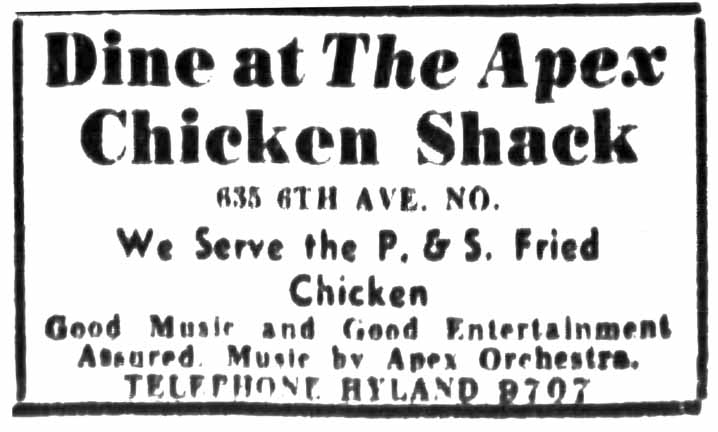
Minneapolis Tribune, May 18, 1935
Rook Ganz and the Apex Orchestra battled it out during a Breakfast Dance that went from June 17 to June 18, 1935.
June 8, 1935 brought Popo Warfield and his Brownskin Steppers for a Big Matinee Dance, accompanied by Johnny Wheeler and His 6-Piece Orchestra. Johnny Wheeler’s combo would entertain every Sunday night starting on June 23, 1935.
In the spring of 1935, Apex Hall owners Ben Wilson and Eugene Moore were convicted and sentenced in district court for operating a house of ill fame. Despite his Mayoral title, Wilson was sentenced to 90 days in the Workhouse. (Minneapolis Star, October 15, 1936)
Rook Ganz and his radio broadcasting Cotton Club Orchestra held forth at a Fourth of July Breakfast Dance that started on July 3, 1935, and ended on July 4. The Apex Orchestra was also on the bandstand.
“After the Aragon,” attend the Breakfast Ball featuring Rook Ganz, beginning at 1:30 am and ending the next morning. When do people sleep?
On August 15, 1935, there was a Battle of Music and Breakfast Ball that started at Midnight. It was a benefit for Citizens Community Union Picket Lines, and featured four bands:
- Rook Ganz and His Cotton Club Band
- Scottie Williams and His Black Cat Orchestra
- C. Sharp and His Seven Flats
- Apex Night Club Band
“Help Us Help Our People”
In August 1935, a small fire on the second floor was reported in the building. Several fires had been reported there in the last few months.
On August 19, 1935, Grant Moore and His Orchestra provided the music for a Breakfast Ball. “Come out and hear a real band,” read the ad.
The Well Known Wee Willie and His Apex Band provided the music for a matinee dance on Sunday afternoon, September 15, 1935.
After that, on Monday night, September 16, 1935, come back for a Breakfast Dance with Rook Ganz and His Radio Broadcasting Cotton Club Band, starting at midnight and ending at breakfast the next day.
After the Ball at the Aragon, Follow the Crowd to the Big Breakfast Dance, Featuring Rook Ganz. There’s no date on the ad, but it’s from the Minneapolis Spokesman dated October 7, 1935.
The Apex really outdid itself on October 19, 1935. Van Epps & Clifton Phelps produced a spectacular floor show that included:
- Mitzi Coleman in her Rhythm Tap
- The Bowen Sisters doing the Shim Show
- Clifton Phelps – Dancers de luxe
- Hamet Five & Van Epps in Underworld Apache
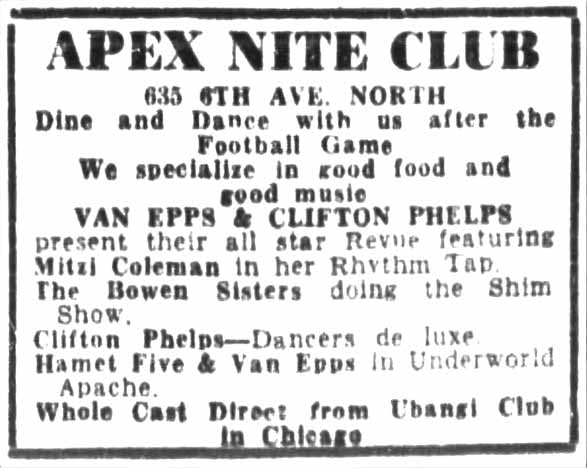
Minneapolis Tribune, October 19, 1935
Halloween 1935 was here and the Apex Hall offered 2 Bands 2: Rook Ganz and His Cotton Club Orchestra, with Bill Pugh, Magic-Voiced Singer, and the Apex Band. The floor show featured Van Epps & Clifton Phillips’ Revue with the Brown Sisters.
November 13, 1935 brought a Cabaret Ball (which was apparently a term of art that I can’t define) featuring Walter Barnes and His Creolians. “Come out and hear this world famous band.”
On November 20, 1935, a dance was given in honor of Noble Sissle and his company. Music was by the Apex Band, and the floor show featured McDonald, Clifton Phelps, Van Epps, and the Apex Chorus. Twin City Musicians and Entertainers will be out in full force to welcome Sissle Company. Sissle was in town for a week to entertain at the Orpheum Theater in tandem with the showing of the Kay Francis movie “I Found Stella Parish.”
Another undated but close-to-Thanksgiving event was a Breakfast Dance with two floor shows featuring Ethel Cross and the Apex Orchestra.
Then beginning on Thanksgiving Eve, November 27, 1935, there was a Cabaret Ball and Battle of Music between two popular nite club bands:
- Clarence Johnson’s Stumble Inn Orchestra
- The Apex Nite Club Band
The First Matinee Dance of the Season was on December 8, 1935, with the Apex Orchestra vs. Clarence Johnson’s Stumble Inn Aces. The Floor Show featured:
- Ethel Cross, the Torch Singing M.C.
- Sonny Nichols, RKO Favorite
- Epps and Phillips, Dancers Excellent
The prizes were a box of cigars for Gentlemen, Combination Cigarette Lighter for Ladies.
December 15, 1935, was a Sunday matinee, where you could dance to the music of Rook Ganz and His Famous Cotton Club Band. See also our new floor show, featuring Ethel Cross, Mistress of Ceremonies.
Christmas 1935 was a test of endurance at the Apex; Christmas night you could hear Ethel Cross, the Torch Singing M.C. and see Pearl Harvey, “Petite Dancer.” Ethel Cross was also the person to call for information. Then the Second Annual Christmas Ball began at 11 pm until 7 am, featuring Rook Ganz’s band, Ethel Cross as M.C., and Pearl Harvey in a Holiday Floor Show. Can one woman a floor show make?
December 31, 1935’s ad said “Now Open.” Ethel Cross and her dancing buddies were featured.
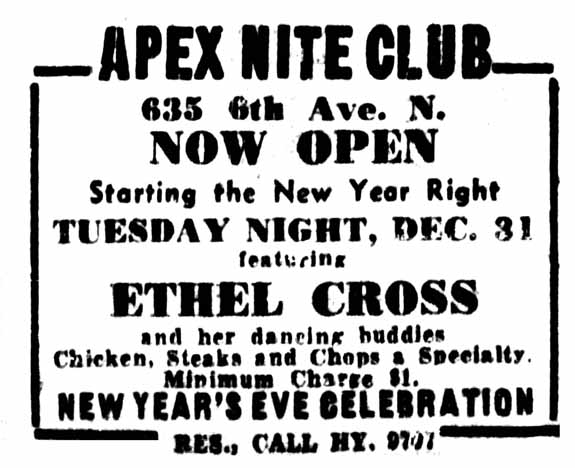
Minneapolis Tribune, December 31, 1935
1936
On February 25, 1936, the Apex Club was raided and Ben Wilson was arrested for keeping the Apex open after hours and serving moonshine whiskey.
Wilson, Eugene Moore, and Esther Kaplan, the owner of the property, were tried and convicted – Moore was convicted for operating a house of ill fame on March 12, 1936. The judge ordered the Apex padlocked on March 10, 1936 for one year.
1937
A fire on October 8, 1937, damaged furnishings in the basement and in the Keystone Bar on the first floor of the building. There was smoke damage to a candy shop and barber shop in the same building, estimated at several thousand dollars. (Minneapolis Tribune, October 9, 1937)
The Apex was back in business on October 10, 1937, with Rook Ganz holding forth at a Sunday Matinee Dance – Cabaret Style. (Given the fire, it’s possible this dance didn’t actually happen since the Spokesman was a weekly and published ads in advance.)
Rook Ganz was replaced by Boyd Atkins, a member of Ganz’s band, at the Cotton Club on April 1, 1936, “and has packed the place to the doors ever since.” Apex dances were being held only on Sundays in 1937. (Minneapolis Spokesman, October 22, 1937)
Boyd Atkins and His Famous Cotton Club Orchestra played at a Sunday Matinee Dance on November 7, 1937. There was also a special floor show.
A few days later the Johnny Backer VFW Post and Auxiliary sponsored an Armistice Celebration and Dance on November 11, 1937, with the Lord Byron Doty Orchestra providing the music.
On November 21, 1937, Apex Hall was the site of the Season’s First Full-Length Cabaret Dance, featuring two Mammoth Floor Shows. Music was provided by the Rook Ganz Orchestra.
An ad in the Spokesman for a Big Thanksgiving Dance on November 25, 1937, just gave the location as Kistler Hall. Music was provided by the Lord Byron Doty Orchestra.
Similarly, on December 31, 1937, the place of the big New Year’s Eve Night Dance, sponsored by the Johnny Baker Post 291 of the American Legion, was just given as Kistler Hall. “Make Whoopee,” read the ad. Unfortunately, on January 7, 1938, the Spokesman reported that “Vandals Attempt to Halt Legion New Year Dance.” When Legion members went to the hall to prepare for the dance, they found every light bulb smashed and the entire lighting system wrecked. The electric power box had been pulled from the wall.
With the old army spirit the post members got together and with the assistance of the Minneapolis Electric Company’s trouble shooter and others, the hall was almost ready at 10 pm when the first New Year’s celebrator reached the hall.
1938
COTTON CLUB CAFE, 635 Sixth Ave. No. THIRD FLOOR
The Cotton Club Cafe opened on May 14, 1938 on the third floor of the Kistler Building, but probably not for long. The ad below promises that there would be entertainment nightly, but focused more on the food, with chicken and steak dinners, sandwiches, and the best barbecue in the Twin Cities. And it was open day and night! It probably had no beer or liquor license, and no matter how good your food is…
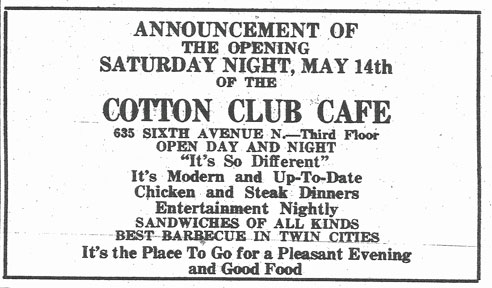
Minneapolis Spokesman
There was just one more ad that I found in the Spokesman, for a Fourth of July (1938) Breakfast Dance and Amateur Dance at the “New Cotton Club,” featuring “Doc” Pettiford and his Swing Band with Floor Show. Dancing and entertainment from 1 am until dawn. Dance given by the Twin City Progressive Club. Not sure if this is the same thing, but the location is given as Sixth and Lyndale.
CLEF CLUB: 1939 – 1943 THIRD FLOOR
The Clef Club was the successor to Apex Hall, and was mentioned in the Spokesman in August 1939 as newly redecorated. Boyd Atkins and his orchestra played a “Jim Jam Jive Session” on Sunday, August 27, 1939.
In November 1939 the Clef Club presented “That Sensational, Petite, Dynamic Artist Dorothy Adams, Direct from Grand Terrace, Chicago, plus Pal Tillman and His Harlem Syncopators.
On October 26, 1940, the club was again described as newly decorated and reopened with a “big imported floor show.” “The Clef Club will be the night club in the Twin Cities catering to Negro patronage,” reported the Spokesman. Manager Scottie Williams promised a show with “a snappy group of entertainers” including:
- Carroll Lee, female impersonator
- Alma Smith, torch singer
- Chase and Ray, the “Brown Dots,” dancers par excellence
- A chorus of “Four Lovelies,” in a show produced by Jackie Hudson
- Music by Walter Lear and His Six-Piece Orchestra
Professional musicians who were in town would come to the Clef Club after their last set and jam all night; the list includes Art Tatum, Benny Goodman, Gene Krupa, Tommy and Jimmy Dorsey, Woody Herman, Fats Waller, Artie Shaw, Charlie Barnett, Erskine Hawkins, Jack Teagarden, Cab Calloway, and Earl Hines, according to Ira Pettiford. Leigh Kamman said that bassist Oscar Pettiford “had his humble beginnings at the Clef Club.” As did his brother, Ira, on the trumpet.
The sessions got to be so popular that matinees were organized in the afternoons, after which the band would go out to the Cotton Club on Excelsior Blvd. in St. Louis Park and play until 1 am. Harold “Popeye” Booker was the pianist at the Cotton Club. Then they would go back to the the Clef Club and really start jiving, said Pettiford.
In December 1940, the floor show featured:
- Jessie Scott (doing the “La Congo”)
- Skip, Hop and Jump: Three Dancing Demons
- Music by Walter Lear and His Gents of Rhythm
The owners were listed as Sylvester Oliver, Ben Wilson, and Scottie Williams.
In January 1941, Earline Williams was the headliner. She was described as a recording singing star, direct from long engagement with Harlan Leonard’s Kansas City Orchestra.
Oh dear. The Clef Club, now “The Home of Happy Feet” presented a gala affair on December 21, 1941, featuring “Snake Hips” and His Rhythm Girls, Peggy O’Neal from Chicago, and Little Bobby Green. Music by Steep Pittman and His Musical Gents. Snake Hips and the gang were also on hand at the Clef Club for a Breakfast Ball on Christmas Eve Night and a dance on Christmas night.
THE GREAT CLEF CLUB RAID
On January 15, 1942, the Clef Club was raided “accidentally” and 89 people were arrested for being found in a disorderly house at 3 am. Police hadn’t intended to raid the place, but they were on their way to another hot spot when they saw 40 or 50 cars outside the Kistler Building and went to investigate. An undercover man went in to “get a buy” of illegal whiskey, and then it was all over. Patrons tried to escape, but the fire escape and the front door were covered. Rumors of 25 people jumping through windows and escaping were unlikely, since it was a 40 ft. drop.
It took two paddy wagons four trips each to get all 89 people to jail. 25 women were fined $10 each. Four couldn’t pay and were sent to the Workhouse for ten days. Horace George Davis, cafe owner, pleaded guilty to maintaining a disorderly house at the Clef Club, and was sentenced to 90 days in the Workhouse. Ben Wilson was fined $25. The other 62 male defendants were fined $10 each. Many of the men said they were musicians playing in theaters downtown or at an uptown night club.
If that weren’t enough, the Minneapolis Star Journal decided to publish the names, addresses, occupations, ages, and races of everyone who was arrested. And a picture of four of the men behind bars. And two more of the women. On the front page. It was a cruel world in 1942.
A Breakfast Dance at the Clef Club on May 29, 1942, featured Mose Strange and His Hot Band.
The Clef Club hosted a Thanksgiving Ball featuring Jimmy Baker’s Orchestra.
The December 25, 1943, Christmas Cabaret Dance at the Clef Club had music by Jimmy Baker’s Band. The large ad for this dance was published in the Spokesman on December 24, 1943.
It was the Clef Club again for a Cabaret Dances on New Year’s Eve, with entertainment and floor show music by Jimmy Baker’s Band. The Breakfast Balls, featuring Walter Lear and His Boogie Woogie Band, started at 10 pm and lasted all night.
Note that there was an organization called the Clef Club in the early 1920s that organized dances, usually held at the South Side Auditorium. Not sure whether there is any relationship.
1946
On October 24, 1946, yet another fire swept through the building, now in use by the York Rite Masonic Lodge. The third floor ballroom was no longer in use, but as a Lodge ritual room. 12 people had been living in the second floor apartments. The building was still owned by Ben Kaplan.
KEYSTONE BAR
644 Sixth Ave. No.
By all accounts, the Keystone bar was inaugurated in 1935 at 644 Sixth Ave. No., which was in a large 2-story building on the NE corner of the same intersection as the Kistler Building.
Its first proprietor was Lawrence Leonard, although it had mob ties six ways to Sunday. On May 22, 1935, it advertised its “Swanky New” Cocktail Room (for Ladies and Gentlemen) (No stags admitted to Cocktail Room) held its Grand Opening. The Cocktail Room was under the Direction of Mr. Duffy Ampey, and the Cafe was under the management of James Wicks. (Minneapolis Spokesman, May 1935)
By June 1935, the Cocktail Room had been renamed the Mystic Cavern. The only Mystic Cavern anyone remembers, however, was in St. Paul.
In November and December 1935, one could be entertained with piano music by Ed Pursell in the main bar, or the Silver-Voiced Baritone Jack Meridith in the Mystic Cavern.
Herman Brown must have been the proprietor in 1937, as he was given 30 days in workhouse on a liquor charge that September.
In 1938, plans were made to remove 644 Sixth Ave. No. for the widening of Sixth Ave. No., and the owner of the building was awarded $22,225. (Minneapolis Star, July 19, 1938) 644 Sixth Ave. No. was wrecked in March 1939.
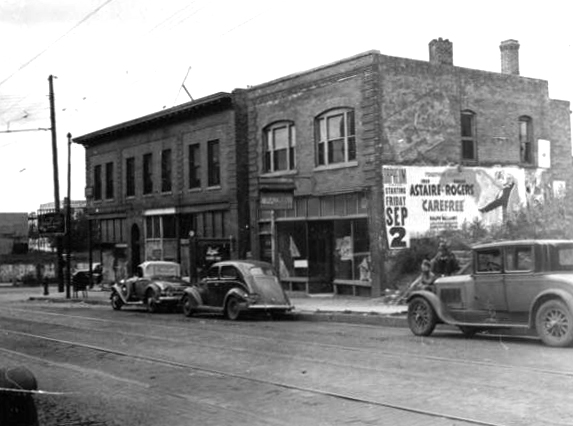
644 Sixth Ave. No., 1938. Photo courtesy Hennepin County Library, via Alan Slacter
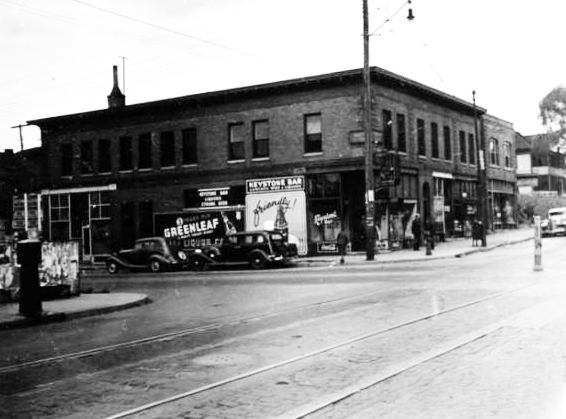
644 Sixth Ave. No., 1938. Photo courtesy Hennepin County Library, via Alan Slacter
THE KEYSTONE AT THE KISTLER FIRST FLOOR
It’s unclear when the Keystone moved to the Kistler, but where it went, trouble followed.
In January 1939, the Crime Sheet says that the Keystone was operated by Joe Miller, and that the player piano was robbed of $25 worth of coins. This happened again in March 1939, if “music machine” is the same as the player piano.
From 1938 to 1956, article after article described shootings, sluggings, robbery, knifings, prostitution, and other quite bad behavior at the Keystone Bar. The proprietors in 1945 were I.
Oleisky and T. Della.
The photos up top and below from February 1957 indicate that the bar was probably there until the bitter end of the Kistler Building.
639 CLUB: 1944 – 1948 FIRST FLOOR
In 1944, this club was one of five that was accused of being an all night club where prostitution, and gambling go on all day and night. This came up in the trial of a case of white slavery. (Minneapolis Star, March 23, 1944) A fire on February 19, 1948, revealed that the 639 Club was on the first floor of the Kistler Building.
EBONY SOCIAL CLUB: 1948 – 1957 THIRD FLOOR
The following comes from an article in the Minneapolis Spokesman dated February 26, 1954:
John W. Ritchie was a World War II veteran who settled in Minneapolis, looking for a business venture. He turned a small shoe shining stand in the Greyhound bus depot into a chain of stands in Minneapolis, Fort Snelling and the Midway, some of which included dry cleaning services.
1948-1949
In 1948 he took over management and ownership of the pool hall in the Kistler Building, and in 1949 he purchased the Kistler building. He remodeled the second floor, converting it into an apartment hotel. On the ground floor he established several businesses including a record shop and a cafe.
1950
Ritchie continued to be the proprietor of the pool room on the first floor. Jerelein May Jones graciously allowed me to post her Facebook comment:
My husband Bart (Hobart) says where the Ebony Club was in the Kistler building, in 1950 it was a pool hall owned and managed by John Richie. Bart says, as a youth of 16, he worked there as a rack boy. When pool players game was over and they called out “rack house,” Bart would rack up the balls for whatever game they were playing (9 ball, 8 ball, rotation,or straight). He would sometimes get tips from winning players who gambled on their game. Bart’s dad, Spence Jones, shot pool there for many years and had a reputation for his skill with a pool cue. The owner, John Richie , was also a skilled pool player and sometimes he and Bart’s dad would “get it on” in a game of 9 ball or straight pool, with spectators standing around watching. Also, in the rear of the pool hall, were card tables, where the gamblers played cards. Tonk and Blackjack were popular, among other card games.
1952
1952 he spent $3,000 to reinforce the floor and roof framing of the assembly hall and the balcony and extend the balcony. In 1954 he remodeled the third floor into a dance hall. Eventually named Ebony Social Clubf, it is described in the Minneapolis Spokesman on February 26, 1954 as a
spacious dance hall with hard wood flooring, supported by two under-floors insulated with sound proofing material. It was equipped to seat over 200 people around the dance floor in seats of the latest vinyal (sic) plastic upholstering material, for easy, comfortable seating.
On one side of the room is a lounge with tables and chairs capable of seating a hundred people. The mezzanine above the lounge enables spectators to view the entire dance floor and the curved bandstand in the northwest corner of the building. A service bar for serving refreshments is equipped for both the Mezzanine and main floor. The hall will be available for parties, lodge meetings and other community meetings.
1954
In July 1954 Ebony Social Club was announced as a new dance hall, “delightfully cooled by nature,” which probably meant there was no air conditioning.
In August 1954 it is revealed that it is the home of George Watson Post 522 and showcased Oscar Frazier and his Combo Fridays through Sundays.
On August 23, 1954, police conducted a raid on the hall, calling them the clubrooms of the George Watson Post 522 and charged Ritchie with operating a public dance without a license. Ritchie was commander of the Post. The club was selling tickets from a ground level booth, making it a public dance. 150 people were in the place when the police arrived, and two bars were in operation. Two bartenders were also arrested. 25 whisky bottles were found and many dancers brought their own bottles. (Minneapolis Tribune, August 23, 1954)
Ebony Social Club held its Grand Opening Dance on December 30, 1954, with music by Eddie Boyd and His Orchestra (Ellis Productions). The next night, Prince Rogers and His House Rockers were the musical attraction.
1955
Lewis Buggs and His Combo, featuring Prince Rogers at the piano for your dancing pleasure, appeared at the Ebony Social Club on January 7-9, 1955.
Tiny Bradshaw and His Orchestra appeared at the Ebony Social Club on January 28, 1955.
An ad in the Spokesman dated August 26, 1955, for the Ebony Social Club says “Plan to Attend our Long Awaited Re-Opening.” Perhaps that escapade with the illegal dance in 1954 got the place shut down for a while.
The Weekend of August 26 – 18, 1955 featured music by Oscar Frazier and His Combo.
By October 1955 it is billed as the “Midwest’s Most Fabulous Spot.”
In December 1955 it is “The Twin Cities Most Beautiful Ballroom.”
James Moody and His Orchestra appeared at the Ebony Social Club on December 30, 1955.
1956
In January 1956, Ritchie was convicted of allowing “spiking” of drinks at the dance hall and given a 60-day suspended jail term.
Danny Overbea and His Orchestra appeared at the Ebony Social Club on January 20, 1956.
Sonny “Long Gone” Thompson and his Orchestra appeared at the Ebony Social Club on February 16, 1956.
As a result of his conviction, in February 1956, the City’s license committee voted to revoke Ritchie’s licenses for both the pool hall and the dance hall. Other people applied for the licenses, but were turned down as they were seen as “fronts” for Ritchie.
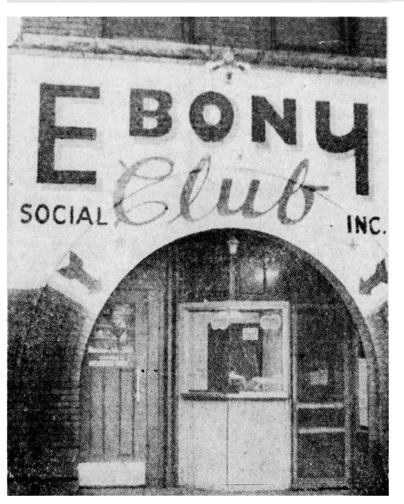
Door to the Ebony Social Club. Minneapolis Star, December 14, 1956
On December 28, 1956, Ritchie’s last hope of operating the Ebony Social Club were gone when the City Council denied his application to renew his cigarette, food, and dance hall licenses. The reason given was his personal police record, although he had no felonies. Ritchie took it to court.
The matter turned out to be academic when the building was purchased and demolished for redevelopment.
1957
END OF THE KISTLER
The Kistler Building purchased by the Housing and Redevelopment Authority on August 16,1957, for $62,000. The building was on 12,500 sq. ft. of land. The demolition permit was issued on October 10, 1957, and the building was demolished as part of the Glenwood Redevelopment Project.
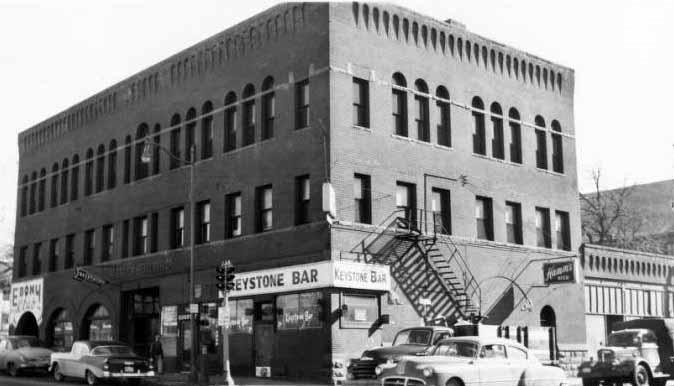
February 26, 1957. Front view from the NW. Photo courtesy City of Minneapolis
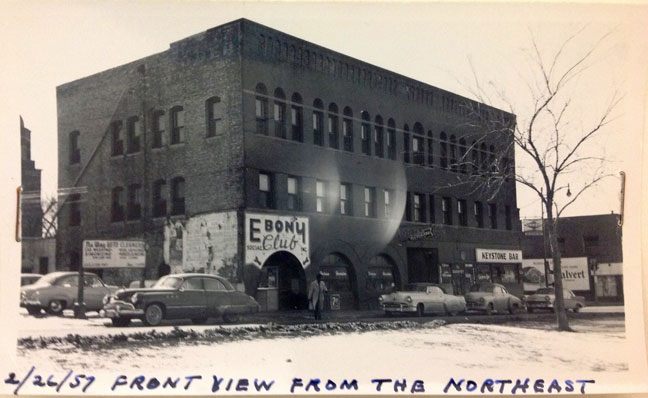
Photo courtesy Kirstin Delegard of the Historyapolis Project
